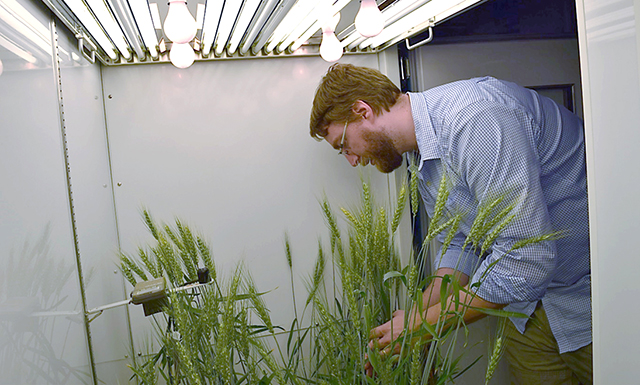
ARS Scientists Readying Wheat with Climate Resiliency
January 12, 2022| |
Scientists from the U.S. Department of Agriculture's Agricultural Research Service (ARS) are preparing wheat for climate challenges ahead.
The scientists are subjecting more than a dozen wheat varieties to two major stressors. The first comes from exposure to carbon dioxide (CO2) levels of up to 1,000 parts per million—an atmospheric concentration of the greenhouse gas projected for the turn of the century absent mitigation measures. The other stressor is infection by the insidious fungus Fusarium graminearum. This fungus causes head blight, a costly disease of wheat, barley, and oat crops worldwide that can damage the grain and contaminate it with mycotoxins, rendering the grain unsafe for food or feed use.
Initially, the scientists compared Alsen, a hard red spring wheat that carries two commonly used genetic sources of blight resistance, to Norm, a popular high-yielding but susceptible wheat variety. Alsen suffered a greater loss in grain nutritional content than Norm, resulting in increased mycotoxin production by certain Fusarium strains. In subsequent experiments, the researchers observed similar responses in an additional nine resistant and six susceptible varieties.
The team is also studying how the fungus itself behaves in wheat plants exposed to high CO2 levels and observed that the severity of blight and production of mycotoxins like deoxynivalenol depends on the fungal strain and wheat variety attacked. They also found that besides protein and minerals, Alsen plants suffered a drop in oleic and linoleic fatty acids, which normally contribute to resistance to blight and other fungal diseases.
For more details, read the article in ARS News & Events.
| |
You might also like:
- High-Iron Wheat Awaits Approval for Field Trials in the UK
- Genome-Edited Wheat Field Trial Gets UK Government Approval
- Scientists Release Genome Assembly for Fielder Wheat Cultivar
Biotech Updates is a weekly newsletter of ISAAA, a not-for-profit organization. It is distributed for free to over 22,000 subscribers worldwide to inform them about the key developments in biosciences, especially in biotechnology. Your support will help us in our mission to feed the world with knowledge. You can help by donating as little as $10.
-
See more articles:
-
News from Around the World
- International Team of Researchers Discover Plant Gene Crucial to Production of Clonal Seeds
- ARS Scientists Readying Wheat with Climate Resiliency
- Coexistence of GM Seed Production and Organic Farming A Success in Chile
- Smart Packaging from Corn Extends Food Shelf Life
- Biotech Crops Get Safety Approval After Pilot Testing in China
- Australian OGTR Receives Application for Field Trial of GM Sorghum
-
Research Highlights
- Anti-stress Function of AtPDI1 Linked to Disulfide Isomerase Activity
- Transgene Inheritance Found to be Stable in Field Grown Pears
- Egyptian Scientists Develop Drought-Tolerant Tomatoes
-
Plant
- CRISPR to Supercharge Lettuce with Nutrients
- Japan's CRISPR Fish Enters Market
- VIB Conducts Three Field Trials of Genome-Edited Maize
-
Read the latest: - Biotech Updates (December 17, 2025)
- Gene Editing Supplement (December 17, 2025)
- Gene Drive Supplement (February 22, 2023)
-
Subscribe to BU: - Share
- Tweet

